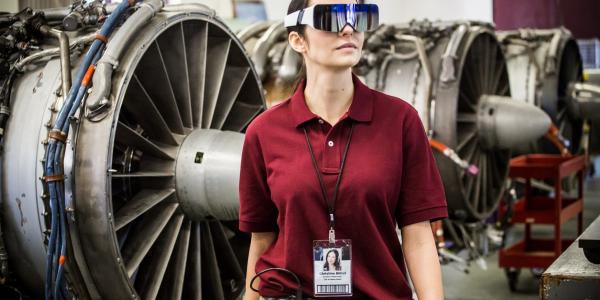Computer Sight Enhances Human Foresight
Powerful augmented reality technologies not only display data for users but also gather information, offering expansive capabilities.
Powerful augmented reality technologies not only display data for users but also gather information, offering expansive capabilities.
Although X-ray vision is not necessarily possible, augmented reality is pushing the envelope of how the world can be seen. Augmented reality technologies, which traditionally use a combination of computer-generated images overlaid on a real-world view, also can scan an environment and take in data, creating 3-D virtual models of what users see.
At the core of this capability is advanced visual inertial odometry, visual and inertial measurements that provide simultaneous computerized localization and mapping information. Drawing data from motion sensors and images, computer processors estimate the user’s change in position in relation to a known area. This application of digital imaging is at the forefront of so-called computer sight.
The GunnAR system, which emerged from the U.S. Navy’s Battlespace Exploitation of Mixed Reality (BEMR) laboratory, uses an augmented reality helmet that depends on computer sight. The helmet acquires, processes and analyzes digital images and adds information to display to the gunner. DAQRI, an international augmented reality company headquartered in Los Angeles, developed the Smart Helmet in conjunction with BEMR under a cooperative agreement, says Paul Sells, director, industrial solutions, DAQRI.
“Naturally, as an augmented reality company, computer vision is foundational to everything we do. It is pretty much our strongest core competency,” Sells says. He also confirms that computer vision is DAQRI’s largest research investment focus.
Sells, a former Navy petty officer and midshipman, initiated and led research efforts on augmented reality for Huntington Ingalls Industries–Newport News Shipbuilding after leaving the service. For the past three years, he and other DAQRI employees have worked with BEMR to develop the helmet. “The cooperative agreement allows us as a technology provider to counsel and share data in an exclusive research capacity to help bring commercial off-the-shelf technology solutions to the Navy,” Sells says.
“Our primary computer-vision product is a tracking technology that empowers our devices to be location-aware,” he states. “So in a known space, say, you were on a ship from a known starting point, you would know where the user’s head was and where it was pointed. That localization capability enables us to produce augmented reality content in your environment. There are other niche capabilities around that localization capability, but that is the primary function for the computerized vision.”
The computer vision also evaluates the environment around a user, captures it and digitizes it. Jason Haggar, vice president, global partner and developer programs, DAQRI, adds, “When we think of augmented reality, there is the notion of displaying data in augmented reality, and there is the ability to capture your environment with the scanning or mapping technology.”
This capturing ability offers the Navy many possibilities, he continues. “Imagine being able to walk into a compartment on a ship and scan the entire compartment very quickly using just your glasses and produce a 3-D model as an output,” Sells says.
Last November, the company unveiled another product, DAQRI Smart Glasses. They run on a visual operating system and a software platform called Worksense, which Sells says is the company’s response “to hundreds and hundreds of customer engagements and requests for enterprise-level software.”
The glasses use enterprise software—such as IBM’s life-cycle system Maximo and its Internet of Things platform Watson, or Honeywell’s building management system—that provides an important link from the asset or maintenance information to the display glasses and the user. “In displaying data, we realized that lots of our customers had already heavily invested in enterprise systems to store things like asset data or 3-D building information or models. What we want to be able to do is unlock data from these enterprise systems and bring it into augmented reality,” Sells says.
The company also is working with Dell and some other large systems integrators to combine devices and technologies to DAQRI’s augmented reality platform for workplace applications. “We believe that in 2018, augmented reality technology is really to the point where customers are seeing the business value every day,” Haggar says. “Now it is about making sure that the solutions they get match their needs.”





Comments